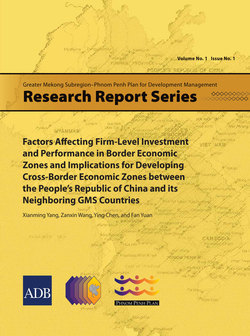Factors Affecting Firm-Level Investment and Performance in Border Economic Zones and Implications for Developing Cross-Border Economic Zones between the People's Republic of China and its Neighboring GMS Countries

Реклама. ООО «ЛитРес», ИНН: 7719571260.
Оглавление
Zanxin Wang. Factors Affecting Firm-Level Investment and Performance in Border Economic Zones and Implications for Developing Cross-Border Economic Zones between the People's Republic of China and its Neighboring GMS Countries
Research Report Series
Contents
List of Tables and Figure
Acknowledgments
Abbreviations
Foreword
Abstract
1. Introduction. 1.1 Background
1.2 Objectives of the Study
1.3 Scope and Significance of the Study
2. Literature Review. 2.1 Factors Affecting Investment
2.2 Incentive Policies
2.3 Developing Cross-Border Economic Zones in the Greater Mekong Subregion
3. Theoretical Framework. 3.1 Theoretical Rationale
3.2 Research Framework
3.3 Methodology. 3.3.1 Secondary Data Collection
3.3.2 Questionnaire Design
3.3.3 Primary Data Collection
3.3.4 Data Analysis
4. Profiles of Border Economic Zones and Industries. 4.1 Border Economic Zones in the People’s Republic of China
4.2 Profiles of Border Economic Zones in the People’s Republic of China–Viet Nam Border Area
4.2.1 Profile of Border Economic Zones in Honghe, People’s Republic of China
4.2.2 Profile of Border Economic Zones in Lao Cai Province, Viet Nam
4.3 Profiles of Border Economic Zones in the People’s Republic of China–Lao People’s Democratic Republic Border Area. 4.3.1 Profile of Border Economic Zone in Mohan, People’s Republic of China
4.3.2 Profile of Border Economic Zones in Boten, Lao People’s Democratic Republic
4.4 Profiles of Border Economic Zones in the People’s Republic of China–Myanmar Border Area
4.4.1 Profile of Border Economic Zones in Dehong, People’s Republic of China
4.4.2 Profile of Border Economic Zone in Muse, Myanmar
4.5 Profiles of Industries. 4.5.1 Profiles of Industries in Yunnan Province, People’s Republic of China
4.5.2 Profiles of Industries in Lao Cai Province, Viet Nam
4.5.3 Industrial Profile of the Lao People’s Democratic Republic
4.5.4 Industrial Profile of Myanmar
5. Active Incentive Policies: A Comparative Analysis
5.1 Comparison of Incentive Policies for Border Economic Zones in the People’s Republic of China (Yunnan Province)–Viet Nam (Lao Cai City) Border Area. 5.1.1 Incentive Policies for Border Economic Zones in Yunnan Province
5.1.2 Incentive Policies for Border Economic Zone in Lao Cai, Viet Nam
5.1.3 Differences in Incentive Policies in the People’s Republic of China (Yunnan)–Viet Nam (Lao Cai) Border Area
5.2 Comparison of Incentive Policies for Border Economic Zones in the People’s Republic of China–Lao People’s Democratic Republic Border Area. 5.2.1 Investment Incentive Policies for Border Economic Zones in Xishuangbanna Prefecture
5.2.2 Investment Incentive Policies for Border Economic Zones in the Lao People’s Democratic Republic
5.2.3 Comparison of Investment Incentive Policies for Border Economic Zones in the People’s Republic of China and the Lao People’s Democratic Republic
5.3 Comparison of Incentive Policies for Border Economic Zones in the People’s Republic of China–Myanmar Border Area. 5.3.1 Investment Incentive Policies of Dehong Border Economic Zones
5.3.2 Investment Incentive Policies for Border Economic Zones in Myanmar
5.3.3 Comparison of Investment Incentive Policies for Border Economic Zones in the People’s Republic of China–Myanmar Border Area
5.4 Summary
6. Nonparametric Analysis. 6.1 General Profile of Firms Surveyed
6.2 Trade Relations among the Countries of the Greater Mekong Subregion
6.3 Investment Motives of Firms
6.4 Locational Advantages of Border Economic Zones
6.5 Importance of Investment Incentives
6.5.1 Tax Policy
6.5.2 Land Use Policy
6.5.3 Investment Services
6.5.4 Finance Support Services
6.5.5 Labor Use Policy
6.6 Assessment of Infrastructure
6.7 General Assessment of Border Economic Zones
7. Parametric Analysis
7.1 Impact of Incentive Policies on Firms’ Investment Motives
7.2 Impact of Investment Climate on Firms’ Investment Motives
7.3 Impact of Incentive Package on Firms’ Performance
7.4 Impact of Investment Climate on Firms’ Performance
8. Conclusion and Policy Implications. 8.1 Conclusion
8.2 Policy Implications
8.3 Limitation of the Study and Further Research
References
Research Team
Отрывок из книги
Volume No. 1 Issue No. 1
Greater Mekong Subregion–Phnom Penh Plan for Development Management
.....
Since the 1990s, the PRC has adjusted its investment incentive policies to attract FDI. Different investment incentive policies have come into force to speed up industrial development. In the process, the establishment of economic development zones in the border areas has played an important role in facilitating trade and the development of manufacturing. However, it is still far from achieving the goal of transforming the southwestern border areas of the PRC into a subregional industrial base centered on processing trade. The expected goal of developing industries based on local resources has not been met yet, and so far only few relatively small-scale industrial projects have been introduced into the economic development zone along the border of Yunnan Province.
It is necessary to assess the effects of current investment incentive policies in border areas. Although there are diverse and multilevel investment incentive policies, they play a limited role in attracting investments to the region. It is also generally the case that neither administrative authorities nor policy researchers assess the effects and, especially, the suitability of investment incentive policies. Thus, it is difficult to know how to improve these policies. The 2008 financial crisis has attached greater importance to subregional international economic cooperation; and the PRC government’s great efforts in building CBEZs, under the policy of opening up to border countries, further highlighting the strategic significance of studying and redesigning existing policies to stimulate investments.
.....